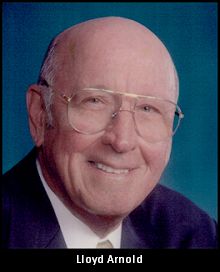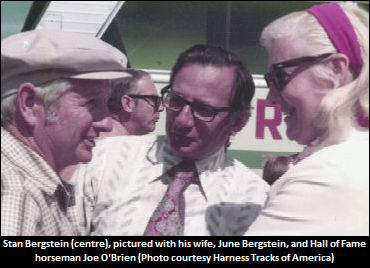Lloyd Arnold and Stan Bergstein, two legendary figures in harness racing, have races named in their honour for this coming weekend’s live action at Cal Expo.
The Lloyd Arnold Pace will be decided on Saturday night, while the Stan Bergstein Trot will headline Friday’s program.
 Lloyd Arnold was an owner and track operator of the highest calibre. He passed away in 2012 at the age of 83. Originally the owner of Arnold Cattle Co. in Iowa, Arnold raced hundreds of horses in Illinois and across the Midwest throughout the 1960s and early 1970s.
Lloyd Arnold was an owner and track operator of the highest calibre. He passed away in 2012 at the age of 83. Originally the owner of Arnold Cattle Co. in Iowa, Arnold raced hundreds of horses in Illinois and across the Midwest throughout the 1960s and early 1970s.
During that era, Arnold raced horses like Warm Breeze, who earned more than $250,000 in two seasons of racing in the mid-1970s, and Dancing David, who earned more than $200,000 in the 1960s. Warm Breeze took Arnold to racing’s pinnacle for the first time when he set the all-age world record over Cal Expo, which was then known as Golden Bear Raceway.
His top horses in later years included the pacing mare Sanabelle Island, who earned $1.6 million lifetime and won 57 of 110 starts. Also of note was Bagel Beach Boy, who won the 2001 Messenger and Matron Stakes.
In August 2003, Arnold bought Chevie Duramax, who then went on to set world records for two-year-old pacing geldings on both mile and half-mile tracks. The fastest three-year-old pacer in North America in 2004 belonged to Arnold, as Quik Pulse Mindale won in 1:48 at Balmoral.
In addition to being a prominent Standardbred owner, Mr. Arnold operated Cal Expo during the Golden Bear Raceway years and also bought Los Alamitos in the late 1980s, eventually selling the track to his partner, Ed Allred.
Arnold was inducted into the California Harness Hall of Fame in April of 2008. He also enjoyed personal honours in 2001 when he was feted by the Delaware Sportswriters and Broadcasters at their annual awards dinner and received the Owner of the Year Award from the U.S. Harness Writers' Association.
Chris Bardis said, “Harness racing was one of Lloyd's great passions. He accomplished so much for the sport not only in California, but nationwide. He was ‘Mr. Harness Racing.’
“He conducted race meetings at Cal Expo, Bay Meadows, Golden Gate Fields, Del Mar, Pomona, Hollywood Park and Los Alamitos. I know of no one else who has had a greater impact on the harness world.”
 Friday’s Stan Bergstein Trot is named for the legendary figure in harness racing that passed away in 2011 at the age of 87.
Friday’s Stan Bergstein Trot is named for the legendary figure in harness racing that passed away in 2011 at the age of 87.
Bergstein was a harness racing titan who advocated for cooperation between the Standardbred and Thoroughbred industries to solve the sports' common problems.
He stepped down in 2011 after many years as the executive vice president of Harness Tracks of America, the Standardbred industry's trade association. He was immediately appointed as the organization's first executive emeritus, and continued to advise the association and write guest columns for the Daily Racing Form until the weeks before his death.
The only person to ever be inducted into the Harness Racing Hall of Fame and its Communicators Hall of Fame, Bergstein worked in a wide variety of roles at racetracks, auction houses, announcer's booths, and racing publications, and he maintained extensive collections of harness racing books and artwork.
He was widely respected not only in the harness industry, but also in the Thoroughbred industry, and he served as a mentor to generations of young racing professionals through a close association with the University of Arizona Race Track Industry Program, located in Tucson, for the past 40 years.
Bergstein was a forceful proponent of forging closer ties between the Standardbred and Thoroughbred industries, most notably in tackling medication abuse and problems with drug testing. In dozens of commentaries, Bergstein maintained that the Standardbred industry's problems were, or would be, those of the Thoroughbred industry, and that neglect of a problem in one sport would damage the other.
Bergstein borrowed from the Thoroughbred industry early in his career, incorporating claiming races as a racing secretary while working at the Chicago tracks in the 1950s. At the time, the harness racing industry did not run claiming races, and they are now as commonplace in Standardbred racing as they are in Thoroughbred racing.
Bergstein also spearheaded the creation of Standardbred Investigative Services, a security agency modeled after the Thoroughbred Racing Protective Bureau.
A native of Illinois, Bergstein attended harness races as a young man and received a journalism degree from Northwestern University. He was the former executive editor of Hoof Beats magazine, and the former vice president of publicity and public relations for the United States Trotting Association.
Cal Expo trackman/program director Marty Bridges credits Bergstein with bringing him into harness racing as a profession.
“After college and two years in the Army, I was employed by the small business association. At night, after work, I was a regular patron at Sportsman’s Park and Maywood in Chicago.
“My supervisor, a former sportswriter for the Chicago Daily News, knew of my interest and called Stan to set up a meeting. Surprisingly, I was to meet him at Du Quoin on Hambletonian Day. Watching Stan call the races from a slightly elevated booth on the infield adjacent to the finish line was thrilling and between races we talked about racing, horses, drivers and trainers.
“His knowledge of the sport was amazing and I had never met anyone like him, and still haven’t. He introduced me to John Tinsley, the program director for all the Chicago tracks and John hired me on the spot. It’s been a great ride, doing something I love.”
Gene Vallandingham first met Stan Bergstein in 1959 when he was working for the legendary Joe O’Brien.
“Stan came to Joe’s farm every spring for the annual Camptown racing weekend, when all of Shafter would be there for a day of racing. Stan was the true voice of harness racing, he was liked by all and I miss him.”
Chris Schick said, "Stan was foremost a kind and compassionate person. He was a true visionary in the harness racing industry. In 1979, well before simulcasting, he so rightly stated the future of the industry was in how well we brought the product to the public. He was also very vocal of the industry for being reluctant to embrace change. Our industry lost a giant when he passed.”
(Cal Expo)

